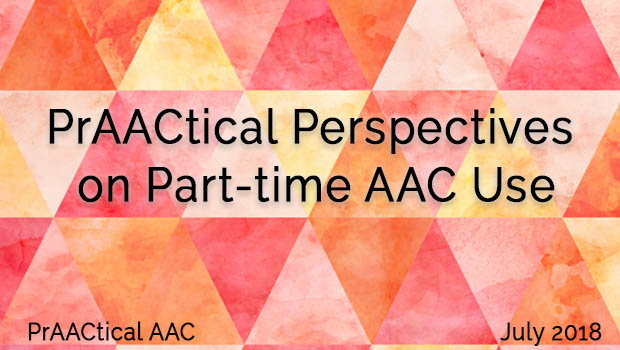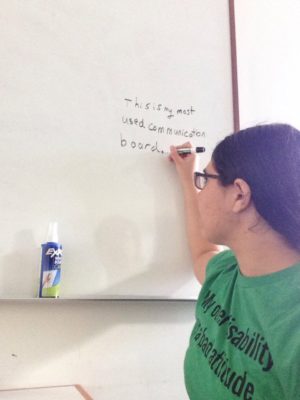PrAACtical Perspectives on Part-time AAC Use

Can AAC be of benefit to people who speak? Today, we welcome Alyssa Hillary Zisk, an Autistic PhD student in the Interdisciplinary Neuroscience Program at the University of Rhode Island, who shares their experiences with part-time AAC use.
::::::::::::::::::::::::::::::::::::::::::::::::::::::::::::

“This is my most used communication board.”
Think about a person who uses AAC. I’m probably not the person you thought of. For one thing, I’m an autistic adult, and the AAC research I’ve seen relating to autism is generally about kids. Services are generally aimed at kids too. For another, my AAC use isn’t the result of having consulted with a specialist who evaluated me and suggested possible strategies. Oh, and my speech sounds pretty fluent, in two languages — when I can talk. That’s not always, and there is the reason I use AAC.
I’ve always had somewhat intermittent speech – that is, I can talk, but only sometimes. For this reason, I use a variety of AAC strategies. I’m not the only one, either – Mel Baggs wrote about this in the days of Autistics.org and Paula was interviewed about it after she made a video. I also have what I would describe as insufficient speech – just because I can say some of the things and even sound fluent, that doesn’t mean I can tell you what I need or how I’m really doing. At least, I can’t do it in real time with mouth sounds. However, it took a while to figure out what was going on and to start using AAC.
You see, I can talk. Mostly. And so very, very few people talk about the grey areas where someone can talk, but only mostly, or only somewhat, or just not the right talking to get our needs met. When I tried to find information about AAC for Autistic adults with some speech, I had a lot of trouble finding anything written by … anyone other than a speaking Autistic adult who uses AAC at least some of the time. And regardless of the trait, regardless of the need, it can take a long time to understand and explain something without examples of it and the vocabulary to do so.
So up through high school, and into college, I relied on my inconsistent speech. By the end of high school, I knew I liked to write, to the tune of taking three semesters of creative writing even though only two were technically offered. But that’s different from using writing as a method of face-to-face communication.
Fast forward to my third year of college. At this point, it’s been figured out that I’m Autistic. (This took a while, too.) Thanks to other Autistic adults, I’ve been exposed to the idea of intermittent speech as a thing, if not yet by that name. I’m starting to realize that the times when I’d get “stuck” in difficult conversations could be that. I’m starting to realize that the times when I haven’t been able to call to my teammates for help on the Ultimate field could be that. And most importantly, I’m starting to try writing or typing when I find myself unable to express myself fully with speech.
There’s a lot of trial and error in this process, as I figure out which methods work best in which environments. I have the free version of Verbally on my iPad, but haven’t used it in several years. I paid for Proloquo4Text when it was half-price and new. It’s my primary speech-generating option for English on my iPad. The only method I’ve used less than speech generation in English is speech generation in Chinese, and that’s partly because I hadn’t figured out an option for it by the end of my year studying in Tianjin. I got the free version of FlipWriter on the suggestion of an Autistic person I met at the Society for Disability Studies conference, and liked it so much I got the paid version within a month. I got the cell phone version, too. That’s my most used AAC app, for sure.
Trying to figure out my AAC use as a teacher is a whole other issue. One on one tutoring, online teaching, medium to large lectures, and electrical engineering labs are four different environments, with four different sets of constraints to consider while I figure out how to teach most effectively. The only constant? My best AAC option is going to vary between contexts.
::::::::::::::::::::::::::::::::::::::::::::::::::::::::::::::::::::::::;
About the Guest Author: Alyssa Hillary is an Autistic PhD student in the Interdisciplinary Neuroscience Program at the University of Rhode Island. Among other areas, they study Augmentative and Alternative Communication, both in the form of brain-computer interfaces and as used by autistic adults. Alyssa hosted a United States Society for Augmentative and Alternative Communication chat (#ussaachat) on AAC in the workplace and uses AAC part-time. You can contact them at alyhillary@gmail.com.
Filed under: Featured Posts, PrAACtical Thinking
This post was written by Carole Zangari

1 Comment
Thank you so much for sharing your insight and personal experience, Alyssa. This is so helpful to those of us who serve children and adults with ASD who present with varying and often inconsistent speech. Please continue to share your experience!